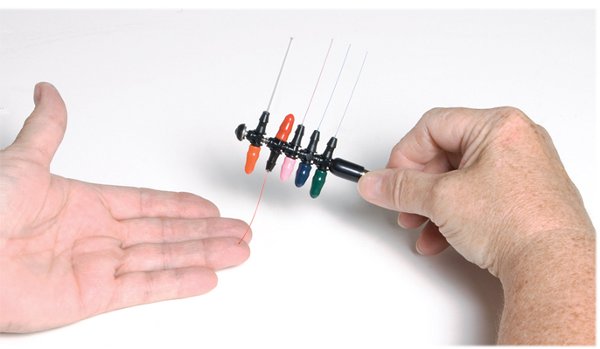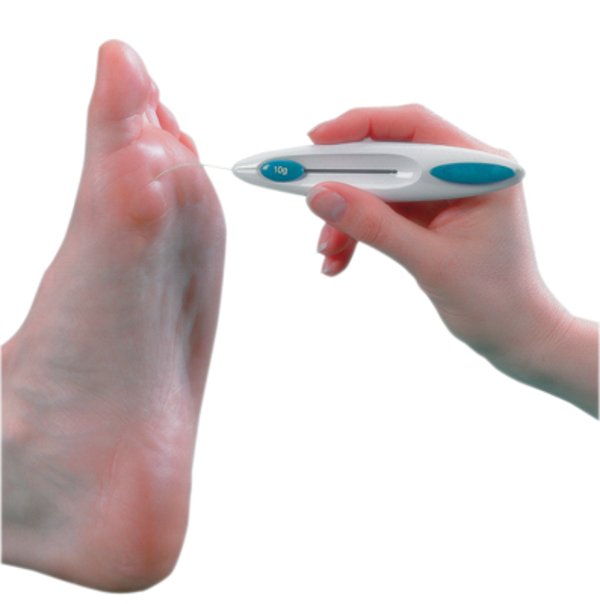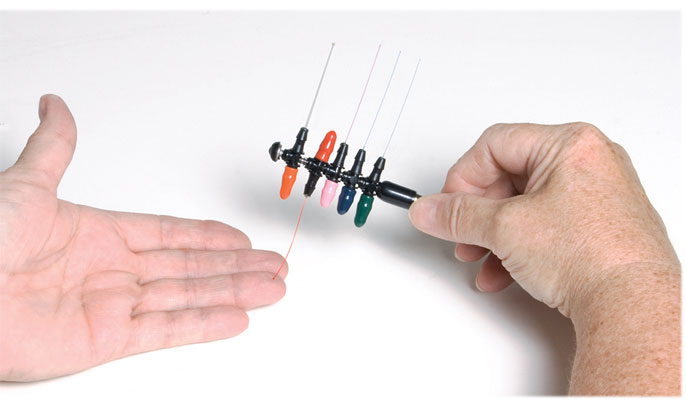 10th Jan 2017
10th Jan 2017
Sensory Testing Using Monofilaments for Diabetes and Carpal Tunnel Patients

Sensory testing is important in evaluating the loss of, if any, components of the sensory system which may be damaged either as a result of disease or injury. Monofilaments are the most effective method of testing for loss of protective sensation (LOPS) in both hands and feet. Each monofilament is a single strand of synthetic fiber that has a unique amount of force that when applied through testing can determine sensory variations from normal to loss of sensory perception. We’ll explore two areas of rehabilitation (Diabetes & Carpal Tunnel Syndrome) where testing with monofilaments is essential in diagnosing sensory loss and prevention of further injury or issues.
Peripheral Neuropathy in Diabetes Patients
The most common reason for Diabetes patients to be hospitalized are for foot infections. These infections can lead to lower extremity amputation and loss of sensation otherwise known as peripheral neuropathy is the first symptom for these types of issues.

Peripheral neuropathy is a widespread problem for patients with Diabetes, effecting up to 30-50% of patients. Unfortunately, a patient’s risk of peripheral neuropathy increases the longer they live with Diabetes. The first sign of peripheral neuropathy is commonly a loss of sensation. This can be detrimental because depending on the level of sensory loss, patients can sustain injuries to the feet more easily. These minor injuries can lead to ulceration and ultimately non-healing wounds that may carry an underlying infection. This progression is the most documented path towards the need for lower extremity amputation.
How to Screen for Peripheral Neuropathy in Diabetes Patients
Early screening is necessary to identify early symptoms of sensory neuropathy. The earlier the prevention the higher the success rate in prevention foot wounds and ulceration in diabetes patients. Once sensory neuropathy has been identified, practitioners can work with Diabetes patients on an early intervention plan including:
- Providing patient education on do’s and don’ts
- Wound prevention and care
- Recommend protective
The tools used to perform early screening for peripheral neuropathy is the monofilament test, which is recommended by the Lower Extremity Amputation Prevention Program (LEAP). To perform testing monofilaments are applied to the following areas: dorsal midfoot, plantar aspect of the foot including pulp (fleshy mass on the distal plantar aspect) of the first, third, and fifth digits, the first, third and fifth metatarsal heads, the medial and lateral midfoot and at the calcaneus. After applying the monofilament to each area, practitioners record the results of the test for each area, noting whether a patient has sensation (+) or not (-). If a patient fails to feel sensation in any area, it is considered a loss of sensation. For example, if a patient can’t feel a monofilament applied to the plantar surface, they have lost “protective sensation” on that foot, in that area. This protective sensation is necessary to help prevent injury and ulceration. With loss of sensation, they are at a higher risk for Injury and require rehabilitative interventions.
Choosing the Right Monofilaments for Testing Diabetic Neuropathy
For preliminary screening, a simple way to begin testing is with a disposable monofilament. Baseline has created disposable monofilaments available in packages of 20 are recommended by the LEAP program and can easily identify patients who require more in depth sensory testing. Once a patient has been identified as needing further sensory testing, a foot testing kit can be used to diagnose the level of sensation loss.
A great example of a sensory foot testing kit is Baseline’s Sensory Monofilament Foot Testing kit which comes with a set of 6 monofilaments:
- 2.83
- 3.61
- 4.31
- 4.56
- 5.07
- 6.65
Having access to varied sizes of monofilaments is important when dealing with Diabetes patients, especially those who may have started to lose sensation. It is standard to start monofilament testing with the 2.83 monofilament. If the patient responds to the stimulus in all sites, they’re considered to have normal sensation. However, if the patient doesn’t respond to stimulus with the 2.83 monofilament, it’s necessary to choose the next largest monofilament and repeat the process to determine how much sensation is lost. Once testing is complete, practitioners can customize a prevention program for the individual. Another option is the Baseline Nerve Impairment Sensory Monofilament Kit which comes with 3 different monofilaments (1 gram, 10 gram, and 75 gram) which can easily identify peripheral nerve impairment.
Sensory Testing for Carpal Tunnel Syndrome
Carpal Tunnel Syndrome is another area where sensory testing with monofilaments is an essential diagnostic tool, helping distinguish mild to moderate and severe cases. According to the Bureau of Labor Statistics, Carpal Tunnel Syndrome is responsible for the highest number of work days lost to injury.
Carpal Tunnel Syndrome can lead to the following symptoms:
- Numbness in hand and wrist
- Tingling in hand and wrist
- Pain and radiating pain
- Weakness in hand and wrist
Symptoms of carpal tunnel syndrome usually start gradually. The most common symptoms experienced are frequent burning, tingling, itching, and numbness in the palm of the hand and fingers.
Choosing the Right Monofilaments for Testing Carpal Tunnel Syndrome
A study published in the Journal of Physical Therapy Science found that monofilament testing was useful in identifying and diagnosing patients with carpal tunnel syndrome, from mild to severe cases. In this initial diagnosing phase, it would be best to use a monofilament testing kit for the hand, like Baseline’s Sensory Monofilament Hand Set, which comes with varying filament sizes which represent unique amounts of force.
The Baseline Monofilament Hand Set comes with the following monofilament sizes:
- 2.83
- 3.61
- 4.31
- 4.56
- 6.65
As with foot testing, having access to different size monofilaments when performing initial testing for carpal tunnel is important in diagnosing the severity of the injury. However, according to the Journal of Bone and Joint Surgery, disposable monofilaments like Baseline Disposable monofilaments are useful in follow-up sensory testing after carpal tunnel release procedures in order to track progress.
Sensory testing is an important part of rehabilitation from testing for loss of sensation to tracking progress in rehabilitation to monitoring deterioration with sensory perception. It is these diverse needs that require the use of different types of monofilaments and kits. With the availability of disposable monofilaments, hand and foot kits, and nerve impairment screening kits, there are sensory evaluation tools for every practitioner and clinic’s needs.
Related Articles:







